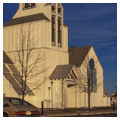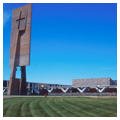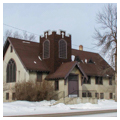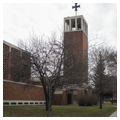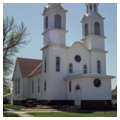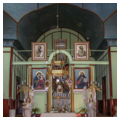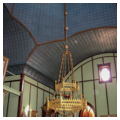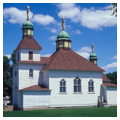North Dakota might be called the “Land of Luther and Leo,” with Scandinavian Lutherans in the eastern third of the state and heavy concentrations of German Catholics in the west. During the territorial years, Methodists, Presbyterians, and Congregationalists utilized portfolios of typical church designs. Eastern architects gladly offered their skills to such plan services in the spirit of altruism and free advertising. Typical L-shaped church buildings with an entrance tower in the reentrant corner afforded equal access to both sanctuary and Sunday school. Dozens of churches of this type were constructed in eastern North Dakota before 1900, though few remain today.
Episcopalians preferred Gothic Revival rendered in split fieldstone and brick, creating a consistent and identifiable image for their denomination before 1900. A remarkable series of picturesque designs began in 1879 at Valley City and continued through the 1880s at Casselton, Buffalo, Lisbon, Lakota, Devils Lake, and other locations, designed by English-born architect George Hancock in collaboration with Bishop William D. Walker.
As the western part of the state settled during the Second Great Dakota Boom, Catholic bishop Vincent Wehrle of Bismarck looked to his kinsmen in Milwaukee for appropriate symbolism. Bavarian-born architect Anton Dohmen of Milwaukee designed churches for Richardton (SK1), Strasburg (EM4), and Mandan and one at Lemmon just over the border in South Dakota, while Fargo’s Bishop John Shanley employed architect George P. Stauduhar of Rock Island, Illinois, for churches in Valley City, Fargo, and rural Dazey (BA10).
Onion-domed Ukrainian churches can be found in Wilton (ML1) and Belfield (SK11), and synagogues in Grand Forks (GF17), Fargo, and Minot. Christian Scientists contributed a classically inspired church in Fargo (CS23), and a Byzantine-influenced Catholic church (WA2) is found in Minto. Akron-plan churches of the Social Gospel movement 1880–1920 are well represented in many progressive communities.
Noteworthy churches were sometimes designed by out-of-state architects, notably Edward A. Sovik’s design for Olivet Lutheran (CS36) in Fargo and Harry Wild Jones’s design of First Presbyterian (KD2) in Steele. Marcel Breuer envisioned the spiritually inspired Annunciation Priory and Mary College (BL18) south of Bismarck. Fargo’s historic Gethsemane Episcopal Cathedral destroyed by a fire was replaced in 2000 (CS38) by Charles Moore–Arthur Andersson, and YHR Partners, with a Postmodern adaptation of Gothic Revival in concrete block and vertical board-and-batten siding.
Writing Credits
If SAH Archipedia has been useful to you, please consider supporting it.
SAH Archipedia tells the story of the United States through its buildings, landscapes, and cities. This freely available resource empowers the public with authoritative knowledge that deepens their understanding and appreciation of the built environment. But the Society of Architectural Historians, which created SAH Archipedia with University of Virginia Press, needs your support to maintain the high-caliber research, writing, photography, cartography, editing, design, and programming that make SAH Archipedia a trusted online resource available to all who value the history of place, heritage tourism, and learning.


